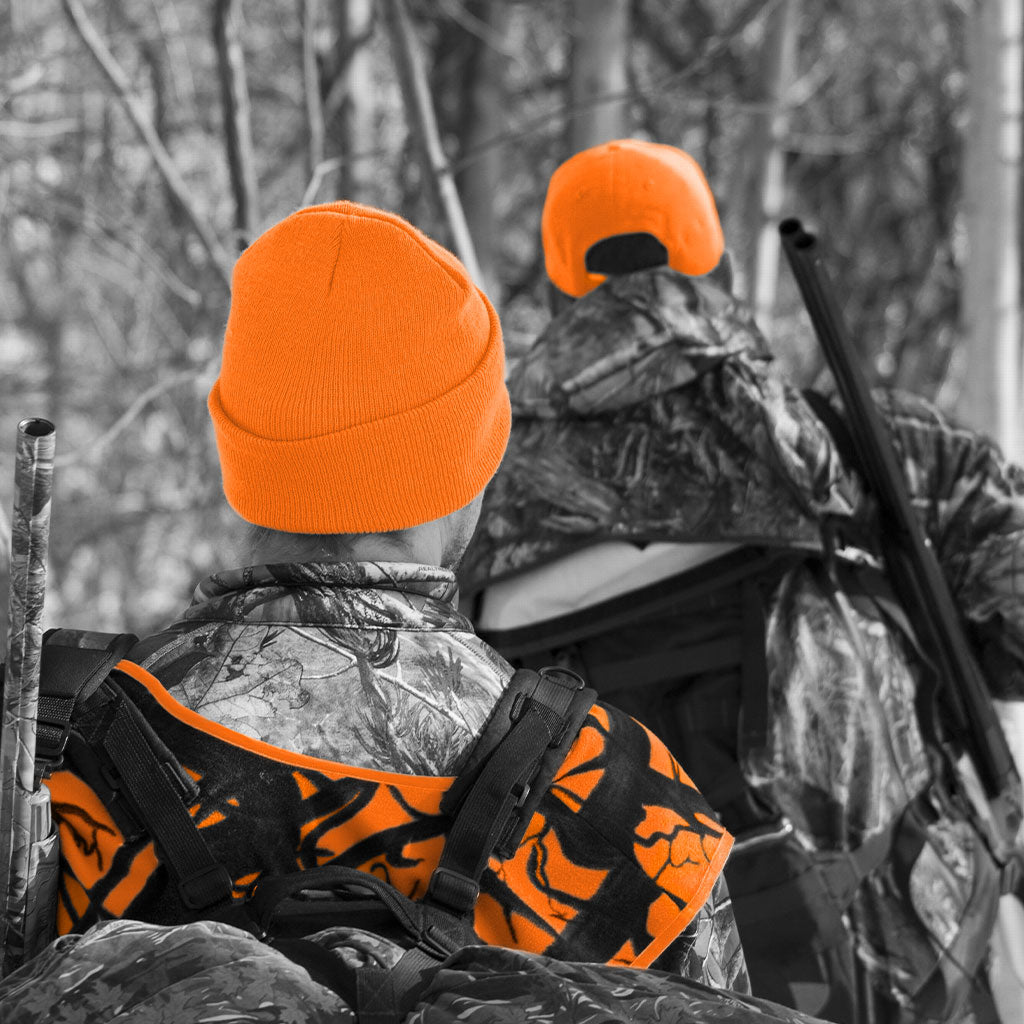Inspired for an Adventure? Check out Beef Stroganoff - Pouch and Beef Stew - Pouch
Free Ground Shipping On All Orders
Over 2,100 Reviews
Add description, images, menus and links to your mega menu
A column with no settings can be used as a spacer
Link to your collections, sales and even external links
Add up to five columns
Add description, images, menus and links to your mega menu
A column with no settings can be used as a spacer
Link to your collections, sales and even external links
Add up to five columns


Fall means crunchy leaves underfoot, crisp sunny days, snow dustings on the mountain ridges, waterfowl on the high-flying wing - and, of course, hunting season. It’s an exciting time of year for those looking to stock up on some venison or elk backstrap; it’s also when a lot of hikers get out into the woods and mountains to take advantage of the often-perfect weather and ambience.
Both hunters and non-hunters have a responsibility to practice safe hunting season etiquette to avoid tragic accidents. In this blog post, we’ll run through some of the basics, and also point you to solid resources for learning more.

The Importance of Hunting Safety
Firearms this time of year obviously pose a risk to hunters and non-hunters alike: people may be mistaken for game or injured by stray bullets or misfires. But that’s not the only risk. The treestands many deer hunters use are statistically some of the greatest hazards of the season, given the potential for falling.
Hunters also must exercise the same kind of outdoor awareness and precaution as any backcountry users, which means having the equipment and knowledge to deal with emergency situations in remote areas. Because of the nature of their pursuit, hunters are more likely than many other outdoors people to travel cross-country, which heightens the chance of getting lost and exposes them to off-trail obstacles and hazards.
Fall also can be fickle in the weather department: depending on the location and the season, hunters often enough find themselves out in the field when, for all intents and purposes, winter is unfolding, and they may have to contend with cold temperatures, sleet, and snow.
Safety Tips for Hunters
We don’t have the space to get into the nuts-and-bolts of basic firearm safety, which obviously any and all hunters should be well versed in. Definitely review these fundamentals - treating every gun as if it was loaded, knowing what’s beyond your target every time, understanding proper loading and unloading procedures, and so on - before your hunt, and make sure all of your equipment is functional. Review safe practices with others in your hunting party, too, so that everybody's on the same page. Check out our “Hunting 101” post if you’re new to the activity!
Treestands
If you’re using a treestand, make sure you secure yourself with a safety harness and a safety rope, and use a haul line to carefully raise and lower your firearm or bow. Maintain three points of contact to your ladder or your steps when climbing to and from your stand. Keep a cell phone on your person at all times in the treestand in case of accidents.
Blaze Orange, Blaze Orange, Blaze Orange
Wear blaze orange, and as much of it as possible. The kind and amount of blaze-orange apparel may be dictated by the regulations of the state you’re hunting in. The following video from Hunter Ed does a good job demonstrating the importance of donning blaze orange during hunting season and the varying visibility of different amounts of it in the field:
(You can find other Hunter Ed hunting safety videos here, by the way - worth checking out).
It goes without saying, we hope, that if you have a dog with you, he or she should be adequately outfitted in blaze orange as well!
Staying Aware of Other Outdoor Users
Ideally the folks sharing the woods and fields with you while you’re hunting are also wearing blaze orange or analogously obvious clothing (see above) and otherwise practicing common-sense hunting season safety. But assume that at least some of the non-hunters out there may lack this knowledge and not be especially noticeable - and, furthermore, assume that some of your fellow hunters aren’t being particularly safety-conscious either.
All of this is to say you should be listening and looking at all times not only for your target quarry but also other people (and pets) out in the woods. That’s a no-brainer for most responsible hunters, but it has to be emphasized.
Basic Backcountry Safety
Always carry wilderness essentials with you while hunting, including extra warm clothes, fire-starting material, a first-aid kit, and emergency signaling devices.
Make sure you share your hunting plan - including your expected itinerary, your planned location, and when you intend to return - with friends or family back home, and leave a written version at your camp or with your vehicle.
Study the weather forecast beforehand and carry a portable weather radio with you so you can keep tabs on potentially dangerous conditions, such as incoming cold fronts or storms.
Safety During Hunting Season for Non-Hunters
If you’re planning on doing some fall hiking, you should find out when and where hunting may be taking place in your area. If you’re not comfortable being out in the field where hunters are active, you usually have plenty of convenient options for outdoor activities in places closed to hunting, such as many state parks, national parks, and municipal greenspaces. You can also time your visits to hunted areas in between the windows of different hunting seasons, or, in some cases, on days when hunting’s prohibited (true, for example, for Sundays in some states).
If you are going to be hiking where hunting is underway, be sure to wear blaze-orange or some other bright, highly visible, non-earth-toned color (white’s not a good idea, particularly during whitetail season, and bright red and blue—otherwise a decent choice—isn’t recommended during turkey season, which may be in fall, spring, or both depending on the location). We’ll re-emphasize the importance of making sure your dog is wearing bright colors, too.
Silent hiking in hunting season isn’t recommended. Whistle, talk, or sing to advertise your presence (and your humanness) to hunters. If you hear gunshots in the vicinity, shout to let hunters know you’re around. If you’ve spotted a hunter and he or she has spotted you, though, be considerate and quiet down until you’re past so you’re minimizing disruption to any wildlife in the vicinity. Don’t engage with the hunter, who is likely trying to stay still and focused.
You should be especially wary in early morning and evening, when animals and therefore hunters are often most active. Try to avoid hiking around dawn or dusk because of this and the reduced visibility, and use a flashlight or headlamp if you are out and about at that time of day.
Staying Safe & Sharing the Great Outdoors During Hunting Season
Here are a couple of other good sources of hunting safety tips:
- U.S. Forest Service: Hunting Safety: Information for Hunters & Non-Hunters
- New York State Department of Environmental Conservation: Hunter Safety Basics
- International Hunter Education Association
- Hunter Ed (Kalkomey Enterprises)
When all outdoor users, hunters and not, practice hunting-season safety, the chances for accidents go down and everybody gets to enjoy what’s typically a fantastic time of year to be out in the woods. Good hunting - and good hiking - this autumn from all of us here at Mountain House!


24 of the Best Trout Streams for Fishing in the U.S

From Catch to Table: How to Properly Clean a Fish Before Cooking


Stay Hungry for Adventure
Sign Up for Delicious Outdoor Meals & Exclusive Offers!
By clicking ‘Join Now’, I agree to the Terms of Service and Privacy Policy.


Join the adventure
©2025 Mountain House — All Rights Reserved.
Your Cart is Empty
Continue ShoppingYour Cart
Subtotal
$0.00
EXPRESS PAYMENT METHODS AVAILABLE IN CHECKOUT
Taxes and Shipping Calculated at Checkout
Your ExpertVoice deal.
$[Deal Price]
$[Original Price]
Discount applied at checkout.
On sale now — lower than your ExpertVoice discount.
Not eligible for ExpertVoice discount.














